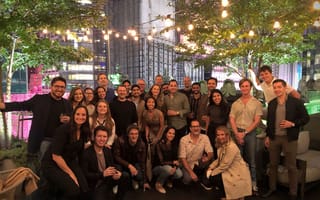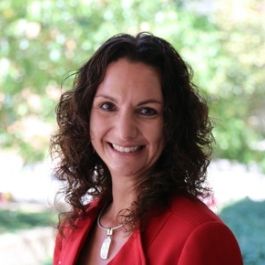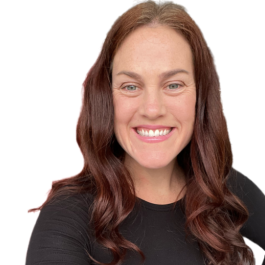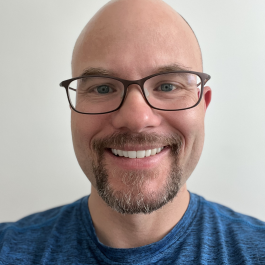Every morning before her workday begins, Elaina Carpino takes a leisurely walk outside with her wife. It’s more than an opportunity to breathe in the crisp air or avoid additional screen time while working remotely — it’s about having the chance to establish a reliable, therapeutic routine by taking time to do what feels important.
Carpino brings that same sharp sense of intentionality into her collaborative work at MURAL.
It wasn’t until recently, however, that Carpino considered herself a “MURALista,” the term MURAL uses to refer to its employees. In fact, before she became the Vice President of LUMA Sales and Operations at the collaborative intelligence company, she had only ever been an avid user of MURAL’s products during her time at the LUMA Institute.
“As an innovative learning experience organization, we had to turn LUMA’s business on a dime from 100 percent in-person professional services delivery to completely virtual during the pandemic,” Carpino said. “If it wasn’t for MURAL’s products, we wouldn’t have been able to do that as effectively or as collaboratively as we did at the time.”
In March of 2022, MURAL announced that it had acquired LUMA Institute and would be uniting their teams to establish category leadership in collaborative intelligence, a new systematic approach that connects teams to unlock their genius. Carpino was to take over as VP of LUMA within MURAL to focus on building connection and purpose as a remote-first organization.
“Now that we’re part of MURAL, I think of it as a peanut butter and jelly sandwich — separately the ingredients are great, but together they become amazing,” she said. “After bringing these teams together into a union, we have a few values that we really embody. One is ‘adapt to thrive’: MURAL and LUMA have both adapted through the throes of all kinds of market conditions. The other is ‘experiment like an owner’: treat every opportunity as an experiment to learn. We take that into everything that we do.”
WHAT IS MURAL ON A MISSION TO ACCOMPLISH?
But what does a heightened sense of collaboration even look like, and how do employees break down those barriers between coworkers in a newly remote world? Additionally, while staying in frequent connection may seem like an obvious choice for increased productivity, how can teams prevent side effects like burnout or the classic “that could have been an email” conundrum?
“There used to be an established mindset — ‘get all the right people in the room and you’ll solve the problem’ — when it came to scheduling meetings. But there really needs to be intentionality in the design of the meeting, workshop or session to make collaboration stronger,” said Senior Manager of Strategy and Enablement Lauren Wolfe. “At MURAL, we’ve learned that successful collaboration is more than just focusing on the outcomes and the technology or methods that we’re using. It’s about bringing them together thoughtfully and embodying what we sell.”
“We always joke that we drink our own champagne!” Wolfe added.
For SVP of Engineering Kirby Frugia, one of his goals after joining MURAL became about redefining what a meeting could look like, and predetermining how much an individual should be prepared to invest in each one. Speaking with coworkers needed to be guided by innovative ideas and a warm welcome — not simply creating a transactional exchange.
“Every time you’re getting people together, every minute of that meeting should be valuable to every person present,” he said. “The only way you achieve that is by planning for it: ‘Who are the attendees? Why do they need to be there? What is the purpose of this meeting? What are the desired outcomes?’ You have to plan ahead, think about everybody’s time and make it a first-class part of what you do every day.”
Today at MURAL, leaders like Carpino, Wolfe and Frugia never feel like they’re leaving teamwork to chance thanks to adding that secret ingredient — intention — to the collaboration process. By fostering its meaning internally through cultural connections like employee resource groups, impactful project meetings and embodying company values, they’re able to show up for their customers authentically and lead by example.
“If we do our jobs well, we can foster that connection for other people all around the world,” Frugia said.

What helps you feel most effectively connected to your employees in a virtual-first work environment, especially as a global company?
Wolfe: I’m running a session tomorrow with a team of 30 people, and I’ve named it “What Video Doesn’t Show But We Should Know.” What I like to think about is how we can dig deeper and find new ways that a fully remote team can share who they are via surprising, unintrusive approaches. It’s about finding creative ways to show me what's on your desk out of a video frame that you love, or what’s in your fridge, or maybe your cat is sitting across from you, judging you harshly. We’re getting to know each other in a way that’s conversational and approachable so that all voices can be heard. A lot of people won’t raise their hand first, so how do you design fun sessions that help to build those bonds and spur future conversations?
My key passion in life is connection. Helping teams establish connections and build relationships is imperative for team well-being and, ultimately company success.
Frugia: I was somebody who hated icebreakers prior to working at MURAL. You would have a prompt like “tell me something deep about yourself,” and I would end up not listening to anybody because I was trying to think of that detail I needed to say on the spot. But if you know your audience, it gets them into the right mindset to participate in that icebreaker and enable the intended conversation that's meant to come after. Sometimes those silly things you get to know — like someone’s favorite movie or a line from a TV show that they often quote — gets people to open up a lot faster to eventually launch into serious discussion.
Carpino: When you step back and think about it from the perspective of what collaboration really is, to me it's a simple formula that starts exactly with trust. When you trust the people that you’re with, and when you are able to open up and be vulnerable with them, you feel safe. When you feel safe — both psychologically and physically, whether you’re an introvert or extrovert — you then feel cared for and deeply connected with one another.
If you take those together as a compounding effect, that’s what creates high-performing, collaborative teams.
It’s a positive spiral of help, so you end up enjoying coming to work every single day because the people are there for you, and vice versa.”
Can you elaborate on a cultural event or company tradition that's helped bring your workforce together?
Wolfe: I lead the Women @ MURAL Employee Resource Group (ERG). We have a great system of leadership support that helped us attain the required funding, but also the spirit behind these groups fosters connection outside of each of our immediate teams. MURAL has various informal communities of people, whether it’s a guild in engineering that people are really passionate about or any other topic where there’s genuine interest, like productivity hacks or talking about our kiddos. These groups bring like-minded folks together with similar missions that may not be their 100 percent everyday focus, but fuels their creativity. There are a lot of random Slack channels that have affinities, like one of my favorites, #miscellaneous-yelling: If you’re ever really mad or really excited, you can pop in and YELL IN ALL CAPS — no judgments ever! We truly have groups for everything, from pets and kids to band name ideas and metalheads to word game competitions.
How have aspects like asynchronous work or pre-work added to MURAL’s collaborative culture?
Frugia: Any important meeting that we hold has a pre-recorded video that gets sent out ahead of time to provide context so people can be mentally prepared for it and come with questions. I think that’s important because some people need that time and space to come up with ideas, and it takes the pressure off of doing that in the moment. Usually there’s a mural created ahead of time where people can ask questions, put feedback and see the conversation for the meeting. We have voting sessions, we have a feature called private mode where people can put their ideas into the mural without worrying about what others may think, and that all leads to a lot of voices being heard that might not otherwise.
I was at a conference once and somebody came up to me and said, “I love MURAL because you allow the quiet voices to be heard.” That really hit home with me, especially being an engineer who oftentimes feels like a conversation may be dominated by two or three people — it can be difficult to interject. But if you give space in a way for people to have ideas and to share those without the barriers of doubt, it has democratized the way everyone can express their ideas of equal value.
Whether they’re internal employees or external customers that use our product that want to learn from the LUMA Institute team, it’s very easy to see the positive impact and value you can accomplish every day.”
What does continuous growth look like at MURAL?
Wolfe: At a company level, MURAL really took a focus on thinking about individualized learning and development by launching MURALvida. It’s a stipend that you can use for any type of learning development or wellness, since it's focused on the “whole being.” On a weekly basis in engineering, we have Architecture Talks, which are my personal favorite. They started in 2019, and every Thursday, without fail, there’s a deep dive on an architectural engineering topic that is awesome. They’re humorous — that’s right, I said humorous technical architectural talks! Not only do they have a sync session with lots of great discussion, but they also use the content to onboard new engineers or share key insights with product folks. Additionally, within engineering, we launched a pilot for an informal mentorship program that’s already made 20 pairings.

How has being a remote-first workforce allowed you to feel more fulfilled in both your work and your personal life?
Carpino: We have the opportunity to bring our full selves to work every day. It allows people of all shapes, sizes, backgrounds and cultures all over the globe to show up exactly as you are every day. What I love about working at MURAL is the fact that we are global and that on any given day I can be talking to somebody in Europe, Asia or even from coast-to-coast in the States.
Frugia: I’m sitting here in my apartment in the Netherlands because MURAL enabled me to move across the world and have a different life experience for myself and my family. It was never a hard conversation. Leadership immediately said that they thought this was something that would embody MURAL’s value of “think global.” I can't imagine in a lot of other places where I would have that opportunity, and now I’m enjoying a very different lifestyle and experiencing a different culture.
Wolfe: I have two small children, and working remotely has enabled me to be fully present at work and with my family and stay sane. Almost any working parent can tell you that logistical juggling is tough, but as a fully global company, MURAL allows me to dictate working hours that are best for me — focusing on output, not hours. There’s never any feeling of judgment about my family obligations. When I look at what I always wanted, it’s exactly what I have now.
MURAL is a registered trademark of Tactivos, Inc.
LUMA System provided by LUMA Institute, LLC, a wholly owned subsidiary of Tactivos, Inc.








